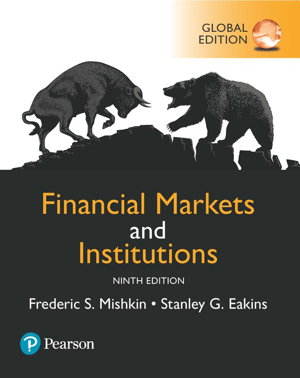
PublishedPearson Education, December 2017 |
ISBN9781292215006 |
FormatSoftcover, 696 pages |
Dimensions25.1cm × 20.6cm × 2.5cm |
For courses in financial markets.
Real-world applications help students navigate the shifting financial landscape
Financial Markets and Institutions takes a practical approach to the changing landscape of financial markets and institutions. Best-selling authors Frederic S. Mishkin and Stanley G. Eakins use core principles to introduce students to topics, then examine these models with real-world scenarios. Empirical applications of themes help students develop essential critical-thinking and problem-solving skills, preparing them for future careers in business and finance. The 9th Edition combines the latest, most relevant information and policies with the authors' hallmark pedagogy to give instructors a refined tool to improve the learning experience. Features
A unifying analytic framework uses a few basic principles to organise students' thinking. These principles include:
Asymmetric information (agency) problems
Conflicts of interest
Transaction costs
Supply and demand
Asset market equilibrium
Efficient markets
Help students transition from classroom to career with real-life business scenarios
Cases demonstrate how the analysis in the book can explain many important real-world situations. A special set of cases called Case: Reading the Wall Street Journal show students how to read daily columns in this leading financial newspaper.
The Practicing Manager special cases introduce students to real -world problems that financial institution managers have to solve.
Following the Financial News boxes introduce students to relevant news articles and data often reported daily in financial news sources and explain how to read them.
Inside the Fed boxes give students a feel for what is important in the operation and structure of the Federal Reserve System, and delve into major changes to monetary policy and lending following the financial crisis.
Global boxes include interesting material with an international focus.
E- Finance boxes relate how changes in technology have affected financial markets and institutions.
Conflicts of Interest boxes outline conflicts of interest in different financial service industries.
Mini -Case boxes highlight dramatic historical episodes, including a special focus on financial crises and trading scandals. These boxes also apply the theory to the data.
Emphasise critical thinking with key features
Chapter Previews at the beginning of each chapter give students an overview of the chapter, explaining why specific topics are important and how they relate to other topics in the book.
Numerical Examples guide students through solutions to financial problems using formulas, timelines, and calculator keystrokes.
Summary Tables are useful study aids for reviewing material.
Key Statements highlight in boldface type important points so that students can easily find them for later reference.
Graphs with over 60 captions, help students understand the interrelationship of the variables plotted and the principles of analysis.
Summaries at the end of each chapter list the chapter's main points.
Key Terms are important words or phrases set in boldface type when defined for the first time and are listed at the end of each chapter.
End -of- Chapter Questions help students learn the subject matter by applying economic concepts, and feature a special class of questions that students find particularly relevant, titled Predicting the Future.
250+ End -of -Chapter Quantitative Problems help students develop their quantitative skills.
Web Exercises encourage students to collect information from online sources or use online resources to enhance their learning experience.
Web Sources provide the URL to data used in the many tables and charts.
Marginal Web References indicate websites that provide information or data that supplement the text material.

